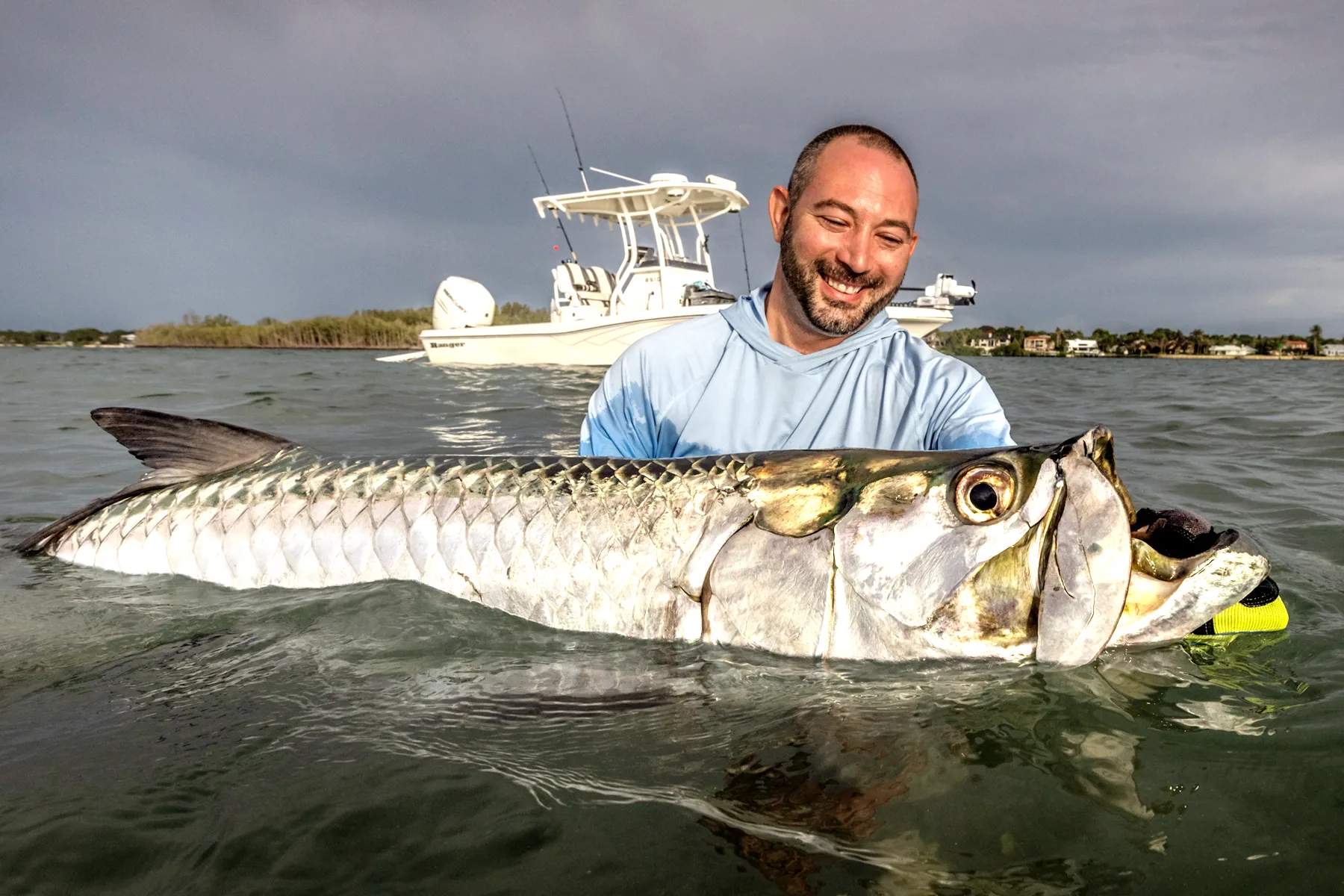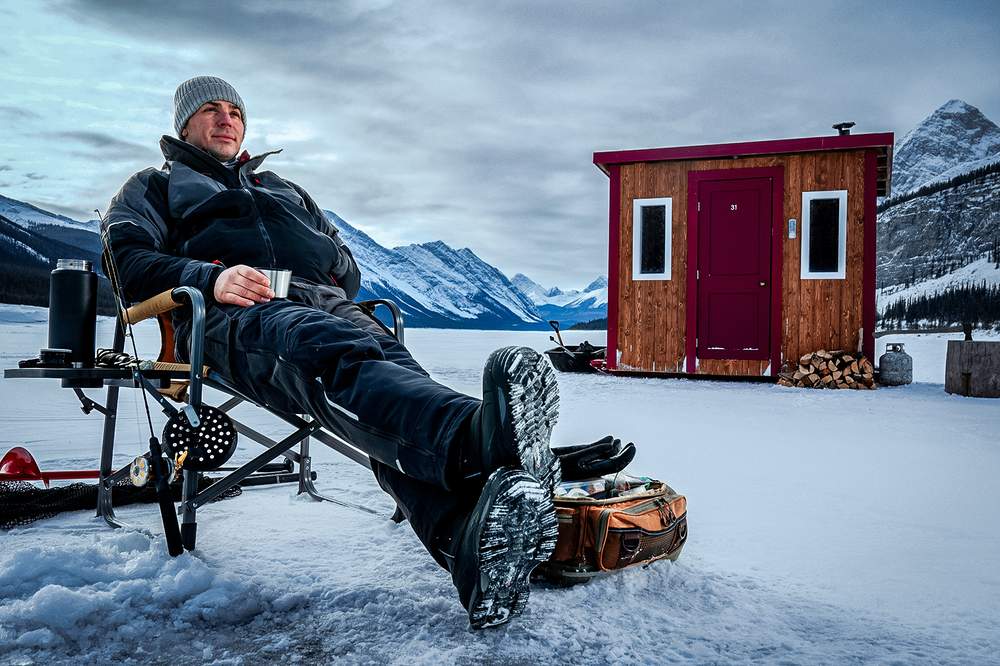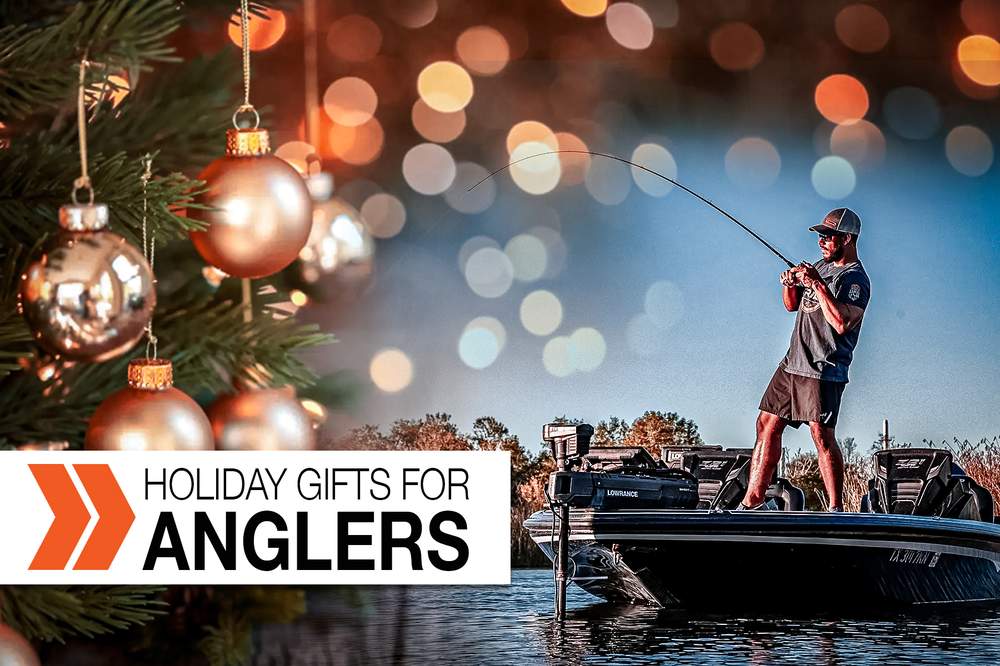Click to listen to the audio version of this article.
A New York Gun Guy Hunts Tarpon, Barracuda, Jack Crevalle & Albacore—Plus A Look At The Tarpon Fishing Capital Of The World
Like most outdoor writers, I’m wired in a way that seems to defy conventional logic, especially when considering how I primarily enjoy the outdoors. For the first 40 years of my life, I lived on an island with abundant saltwater fishing opportunities in one of the worst states for gun owners. My options were to embrace the freedom of the open seas or cut through a mile of red tape to pursue a career involving firearms. I chose the latter and still battle with New York State to restore the rights many have fought and died for.
New York Saltwater Angling Roots
Now, that doesn’t mean I don’t enjoy wetting a line time and again; nothing was better than getting out with Dad and my uncle to fish Jones Inlet, the Long Island Sound, or even Montauk Point. With water never more than a few minutes away, I was raised a bit lax regarding targeting. The idea was to anchor or drift where you could, and if the fish were there, we’d catch them. If not, we could always try again tomorrow.
The idea of using a trolling motor for assistance was never considered, especially when you take into account the typical motor’s life expectancy when exposed to saltwater. To be honest, if you have unlimited time and patience, this method works just fine. However, if you’re a serious angler aiming to capitalize on a specific phase of the season or need to engage the fish on their terms, you better have a reliable trolling motor.
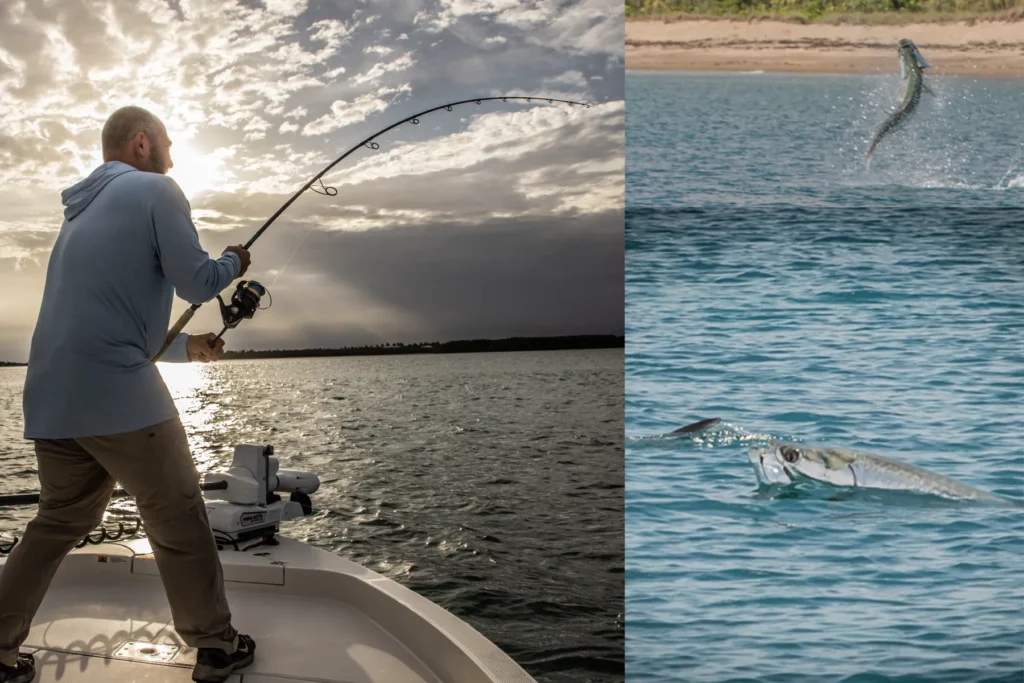
Let’s Troll—Minn Kota Style
Just a few weeks before this writing, I received an invitation to work with the Minn Kota pro staff in Stuart, Florida, to gain some hands-on experience with their creation, the Riptide Instinct Quest. Due to my upbringing, I had little knowledge of the brand, so I did some research before printing my boarding pass. What I found blew my mind, as my entire concept of a trolling motor was apparently skewed.
These weren’t trivial little kickers but rather advanced technological equipment capable of automating several tasks that would normally rob you of opportunity.
Combining GPS correction and fish finder integration, Minn Kota’s products transform your boat into a fish-seeking Tesla. Furthermore, the Riptide series is sealed and ruggedized to withstand corrosive saltwater, taking electric trolling motors far beyond lakes and ponds. I was so excited about the opportunity that I overlooked the fact that a targeted species wasn’t listed on our itinerary. That was because we were going after everything.
Questing For Jack Crevalle
Day one began under the guidance of Captain Cody Rubner from High Roller Guide Service. A marine biologist by trade, his knowledge of the local aquatic life was impressive. He arrived on a Pathfinder 2300 HPS, fully equipped and ready to pursue whatever we encountered. It only took a few minutes of patrolling the Indian River Lagoon before we spotted a massive school of jack crevalle running parallel to the beach. The most common plan of attack is to loop wide using the outboard and then quietly cut them off to throw a plug in their path.
To achieve this, you need to be both deliberate in your movements and quiet in your approach. The Quest series is designed with a brushless motor, which excels in both areas, and this particular model activates with the push of a button. Utilizing this feature set, Captain Rubner was able to set the Riptide on course while providing me with an overview of our tactics. It didn’t take long before my partner, Dustin, hooked a monster, and I quickly followed with a 30-pounder, marking this as my first Florida fish and a new species to add to my resume.

Wreckin’ False Albacore
We continued with this cadre for another five or six runs, amazed by how quickly this motor pulled nearly 4,000 pounds of boat, bringing us within mere feet of the jacks’ noses. After bringing a third aboard, we sought deeper waters and targeted the false albacore that inhabited a well-known wreck just offshore.
In this scenario, we utilized the spot-lock feature, which effectively employs the system’s GPS to anchor us in position. Dropping a line directly over the wreck was crucial, so we employed the jog feature to adjust our position in 5-foot increments until we were right over our target. Within just a few minutes, I had an 8-pounder in my grasp, thanks to the clever use of some threadfin chum.
Oooh, Barracuda
In certain instances, anchoring simply isn’t an option. As I write these words, I think of the countless anchors sacrificed to the footings of the Throgs Neck Bridge. Reminiscent of this scene, we fished the cooling water intakes of the Martin County Nuclear Power Plant in pursuit of barracuda, which was a bucket list fish for me. This species also requires pinpoint accuracy to catch, as the lure must be cast into their line of sight and retrieved as quickly as possible. Using the Minn Kota, we were able to hold a position despite the swirling current generated by the power plant.
Needless to say, this would be nearly impossible with an anchor, especially if retrieving it is among your priorities. It took a few attempts, but both Dustin and I managed to get one to play, marking this as my third consecutive new species to hit our deck. Our success came just in time, as we were racing against the last minute before that batch of heavy storms in the distance rolled into our position. As we hurried back to camp, I sat in a mix of awe and regret upon realizing just how much utility these trolling motors truly had.
Finding Tarpon Via Humminbird

The next morning, we awoke to clear skies, though the horizon looked ominous. As daylight broke over the bow, we knew right away that if we were going to make something happen, it would have to be early, and we had no time to waste.
That day, I would be under the guidance of Captain Ed Zyak, a 26-year veteran of these waters whose experience played a crucial role in our favor. His wisdom, combined with the side imaging technology of our Humminbird fish finder, positioned us to locate some legendary Floridian tarpon in no time. With the heavens ready to open up on us, we decided that staying close to shore would be a smart move and one more likely to yield results, as the reduced beach occupancy would attract bigger fish closer.
As we scanned the channel, we marked several silver kings in a concentrated area and utilized the One-Boat network to remain in what was shaping up to be an exceptional neighborhood. In simple terms, this is an integration of the motor and fish finder to keep you in a designated zone. This may have been the most fascinating deployment of the motor that I observed. As the winds changed and the tide carried us beyond our limits, the Riptide automatically detected our position and navigated us back within our perimeter. Each correction was gentle yet powerful, propelling the 25-foot Ranger as if it were an inflatable raft.
Within minutes, we watched as a 100-pounder engulfed the blue crab we had floated behind us, narrowly missing the hook. After sending out a second one, it took only another 15 minutes before his little brother decided it was his turn, but he wasn’t quite as lucky. Watching the rod bend in half and what seemed like 100 yards of line leave the spool, Captain Zyak started the outboard, hit the auto-stow on the trolling motor, and began the chase.
After a choreographed series of alternating tugs and cranks, a 15-minute battle brought the 70-pounder alongside. I’d like to say that my years of expertise kept the fight short, but we know that’s not the case. The reason I returned home with my biceps intact is that we managed to tackle that monster without needing to run to the bow to manually stow the trolling motor, as every second counted toward the yards of line we had to reclaim.
Fishing Tech Takeaways
There are many ways to quantify the benefits of quality gear, but I believe the best metric for this trip is that I connected with four new species in less than 10 hours on the water. Minn Kota’s Riptide Instinct Quest got us where we needed to be, kept us where we needed to stay, and stepped aside when we needed it gone. Combined with top-tier captains and well-maintained equipment, it’s no surprise that we were so successful.
Furthermore, we were able to share a sense of accomplishment, as the motor didn’t compensate for a lack of skill; rather, it economized our efforts. I believe Captain Rubner summed it up best when he said, “Technology fills the gaps between instinct and ability, allowing you always to be effective.” Having the right gear on board made all the difference on this trip and has profoundly changed my perspective on trolling motors. Drifting is certainly relaxing, but if you can’t position your boat where you need it, there’s little reason to leave the shore.
For more information, visit minnkota.johnsonoutdoors.com
Meet Captain Cody Rubner & Ed Zyak
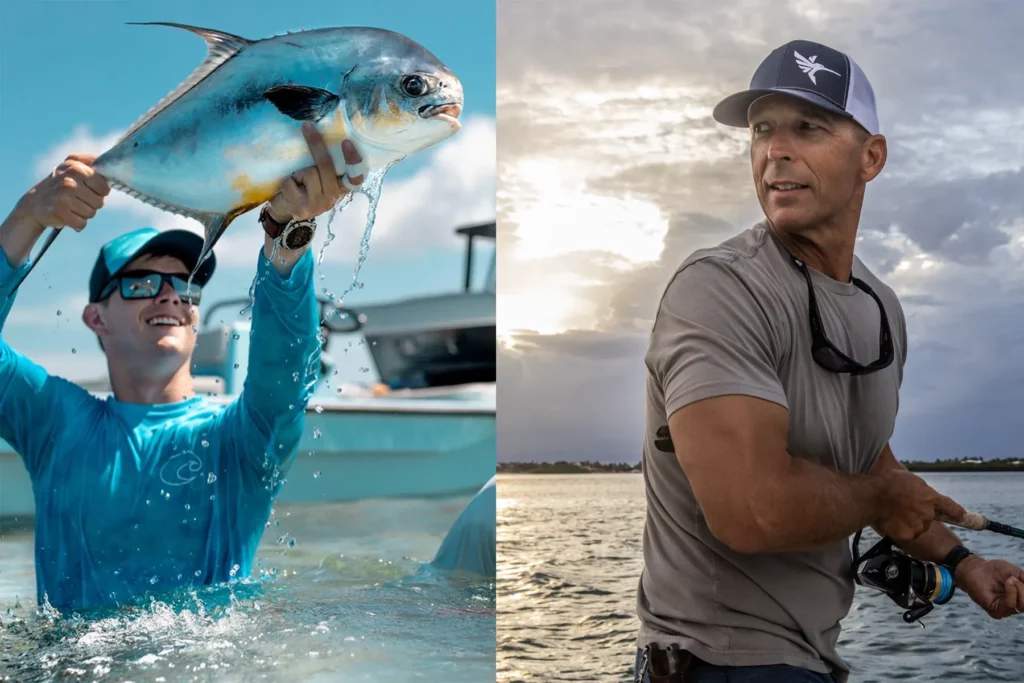
Captain Cody Rubner kitted out each angler with exceptional gear for this saltwater fishing trip. Using a Shimano Saragosa reel and a Nomad Seacore rod, fighting in the ’cuda, jack crevalle and false albacore was effortless. Capt. Cody rigged up a variety of plugs, tubes, and live bait to seal the deal, making our relatively short outing outlandishly productive. His time spent involved with the Albie project, and now the Jack project, has given him an inside track at finding these species and predicting their movement, so all it took was the right tackle and a little instruction to land everything we targeted. For more interesting information on Cody’s current project or his fishing service, visit
highrollerguideservice.com.
To hook up with Captain Ed Zyak, the man who made my bucket list tarpon a full-on reality, connect with Captain Ed Zyak’s Guide Service on Facebook. As you’ll see from the testimonials and amazing trophy photos, Ed has what it takes to make your Florida saltwater fishing dreams come true. —Frank Melloni

Boca Grande: The Tarpon Fishing Capital Of The World
No discussion of saltwater fishing in Florida is complete without mentioning Boca Grande, the Tarpon Fishing Capital of the World. Its unique position along a tarpon migration route on Florida’s Gulf Coast (yes, opposite side of Florida from where author Frank Melloni fished with Minn Kota) has made it a dream destination for anyone who has ever aspired to battle the silver kings. Whether you’re enjoying a saltwater fishing vacation or competing in its annual tarpon tournament, Boca Grande is a must-visit for any avid angler.
HOTTEST SPOT: Boca Grande owes its abundance of tarpon to its namesake, Boca Grande Pass, an 80-foot channel that connects Charlotte Harbor to the Gulf. The pass is teeming with marine life, so migrating tarpon stop there to feast on the crabs and squirrelfish that float on the tidal surface. Anyone who has used a fish finder will tell you it’s stacked from top to bottom with tarpon, making it nearly impossible not to hook one.
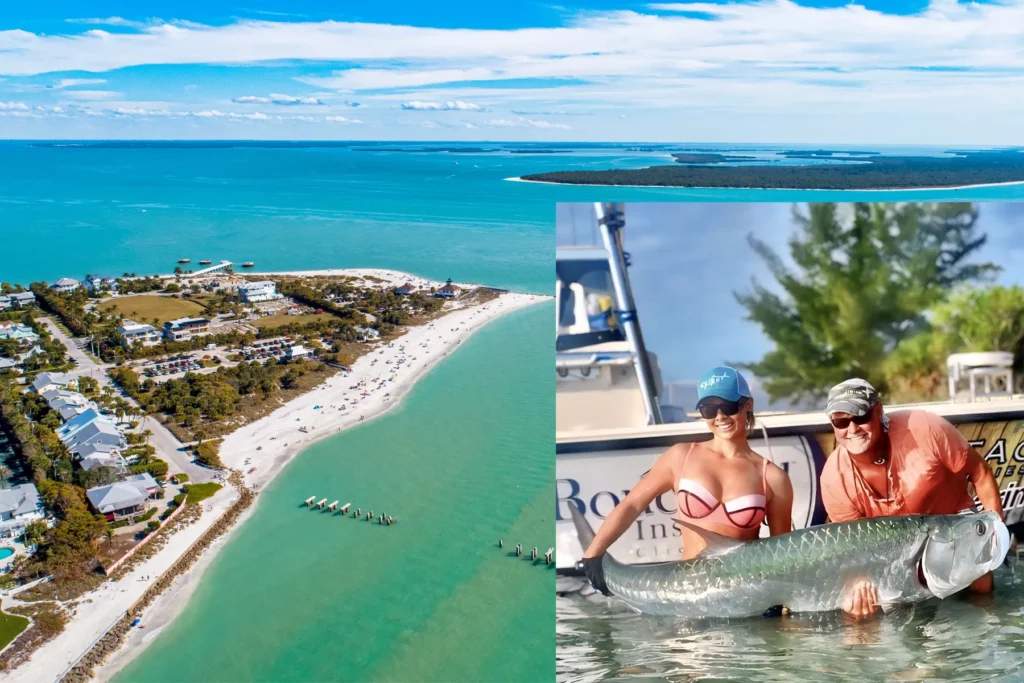
TARPON TOURNEY: Tarpon season runs from April to July, and the earlier in the season you go, the better. The height of the season occurs during the World’s Largest Tarpon Tournament, traditionally held the second week of May. At its peak, the tournament’s first prize exceeded $100,000, and it even once awarded a boat to the winner. Today, first place takes home around $40,000, with an additional $10,000 prize for the first and last tarpon caught each day. Last year’s tournament saw 20 boats catch 133 tarpon over two days, fishing from 3:30 to 7:30 p.m. Do the math, and that’s between one to two tarpon per hour, per boat.
DIY OR GET A GUIDE: Of course, you don’t need to shell out the $7,500 entry fee to battle tarpon in Boca Grande. You can bring your own boat to the pass or contact the Boca Grande Fishing Guides Association to find a captain and a charter boat. All tarpon fishing is catch and release, and if you’re aiming for a record or trophy fish, you’ll need to pay $50 for a tag.
GASPARILLA INN: While tarpon fishing has been Boca Grande’s main attraction for over 100 years, the town didn’t begin as a fishing village. Initially, it was a phosphate port, and it wasn’t until the Gasparilla Inn opened in 1913 that tourism became Boca Grande’s primary economic driver. Along with the typical sun and sand, Boca Grande also offered visitors world-class saltwater fishing, which was unavailable up north, contributing to its legendary status.
The historic Gasparilla Inn still stands today and remains one of the most iconic hotels in Florida. It has an attached marina, so if you have your own boat, you can arrange to dock it there during your stay. Guests can also arrange saltwater fishing charters through the Inn’s private concierge. While it’s not the only hotel in town, many saltwater fishing groups prefer larger vacation rental homes where they can spread out and cook their catch at night, as Boca Grande is also a great spot for snapper and redfish.
Wherever you choose to stay, Boca Grande truly lives up to its title as the Tarpon Fishing Capital of the World. For a few days of battling some of the fastest, most athletic fish in the ocean, no other destination offers as much. —Matt Meltzer
